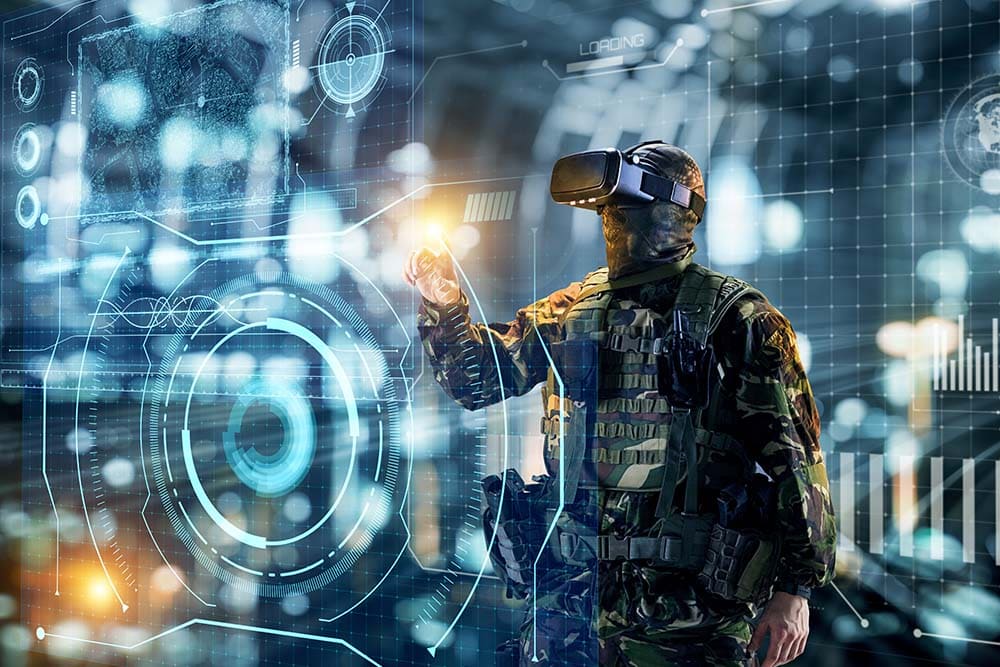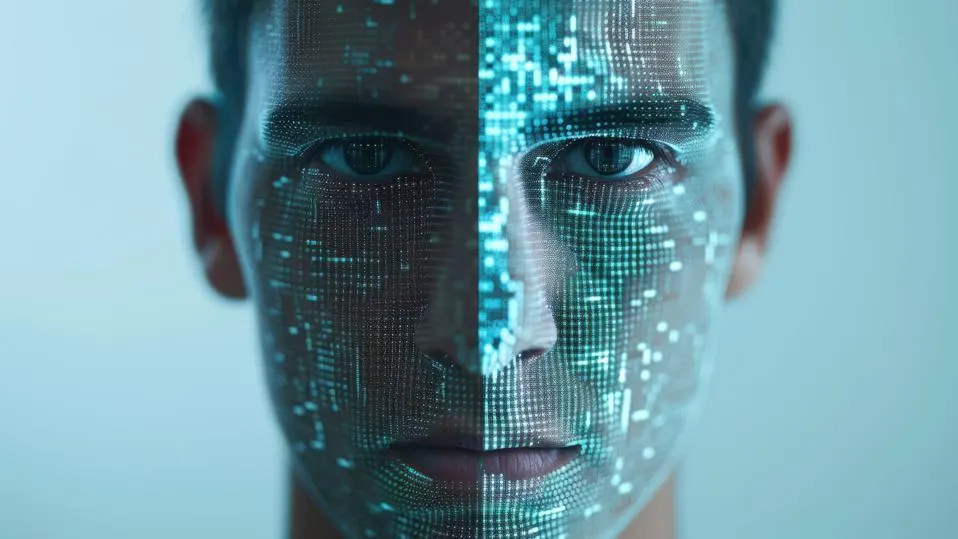How Augmented & Virtual Reality Is Used In Law Enforcement And The Military
11 October 2021
Even if you aren’t in the military or law enforcement, some of the extended reality (XR) use cases coming from these sectors are really inspiring – demonstrating the sheer awesome capabilities of XR and how it can be used to improve decision-making and keep people safe. Let’s take a look at some of the amazing XR innovations being used in practice.

XR in law enforcement
Law enforcement use cases tend to center around augmented reality (AR) or mixed reality (MR) – as these technologies aren’t as immersive as virtual reality (VR), thereby allowing officers to maintain awareness of what’s going on around them.
The FBI says that AR’s ability to overlay information or images onto a person’s real-world view can help officers accomplish a variety of tasks and assignments more efficiently – potentially to the point where one officer equipped with AR technology could complete the same work as three unequipped officers.
In China, AR glasses are being combined with artificial intelligence (AI) and facial recognition software to help police officers on the streets identify suspects. Chinese AR specialists Xloong developed the smart AR glasses for police back in 2017, and the glasses have since been adopted by Chinese law enforcement authorities at highway inspection points and airports, as well as in six local public security bureaus, including Beijing. The glasses – which look like sunglasses – allow police officers to access national database information such as facial recognition and ID card data and vehicle plate information, all in real-time. The idea is to catch suspects and people traveling under false identities. Of course, there are huge privacy concerns around this sort of usage, and the technology is clearly open to misuse (identifying journalists or activists, for example). But there's no denying it is a powerful example of how AR can equip officers with valuable real-time information.
While we may never see police officers in Western countries using AR glasses to identify people in real-time, AR is still finding other uses. Aiding criminal investigations is one area where AR seems to have significant potential.
Processing and preserving all the evidence at a crime scene is a slow, intricate process – and the first officer on the scene may not be the most qualified person to identify and preserve evidence. Any mistakes in preserving physical evidence or securing a crime scene can hamper an investigation, but this is where AR or MR can help. The tuServe mobile policing app, which works with Microsoft HoloLens MR headsets and mobile devices, is designed to help police officers on the scene. The app maps out the crime zone, captures digital evidence and allows officers to place virtual markers, without disturbing the physical scene and potentially tainting evidence. The digital version of the crime scene can be shared with other detectives, so they don’t have to be physically present at the scene, and can be used to (digitally) transport investigators back to the scene, so they can recall every detail of the scene long after it has been cleared.
Military uses of XR
For troops on the ground, AR displays and glasses can deliver improved situational awareness – meaning troops can locate their position precisely, locate others around them and accurately identify whether others are a friend or foe. Such displays can also show other information, such as the distance to target, bringing to mind images of superhuman, Terminator-like soldiers.
In 2020, the US Army announced it was investing in 40,000 pairs of MR goggles (which is enough to outfit 10 percent of soldiers). Derived from Microsoft’s HoloLens technology, the IVAS (Integrated Visual Augmentation System) goggles display critical information and are designed to help troops identify enemy forces and make decisions more quickly. Plus, the goggles are equipped with thermal and low-light sensors to help the user see in the dark. What’s so important about MR systems like this is they are far less distracting than handheld systems. With goggles, the user never has to take their eye off the battlefield.
Eventually, IVAS goggles could incorporate facial recognition capabilities, or link with weapons to give soldiers the ability to fire without even seeing the enemy – meaning the soldier can “see” through the sight of their weapon using their goggles, so they can, for example, hold their weapon around the corner of a building and accurately fire, while remaining safely under cover.
XR-enhanced training for both military and law enforcement personnel
So far, I haven’t really mentioned VR because it’s not well suited to operational use. But one area where VR excels is in creating immersive training experiences – particularly when it comes to simulating dangerous scenarios or events that would be difficult to simulate in real life.
One of the obvious applications of VR in military training is to make flight simulators more realistic. In fact, the US Air Force is turning to VR to help speed up the process of becoming a pilot and address pilot shortages as experienced older pilots are tempted away to commercial airlines. One initiative to address the shortfall of pilots is the experimental Pilot Training Next (PTN) program, which incorporates VR and AR technologies to decrease the time and cost of training. The UK’s Royal Air Force is participating in the program.
Meanwhile in police training, there are innovations like the VirTra VR police training tool, which can be used to train police officers in hundreds of simulated scenarios. Law enforcement officers in Camden County Police Department, New Jersey are using the VirTra VR simulator to train for more than 230 real-world scenarios they may encounter – covering everything from a routine traffic stop or domestic violence callout to mass shooters. In the 360-degree simulations, officers learn how to de-escalate dangerous situations wherever possible, and when to use force. The same technology is used by a range of military and law enforcement agencies.
Read more about extended reality technologies in my new book, Extended Reality in Practice: 100+ Amazing Ways Virtual, Augmented and Mixed Reality Are Changing Business and Society. It’s packed with real-world examples from law enforcement, the military and many other industries.
Related Articles
The Rise Of AI-Enabled Virtual Pets: Why Millions Are Raising Digital Companions
Remember Tamagotchis? Those tiny digital pets that had millions of kids frantically pressing buttons to keep their virtual companions alive in the 1990s?[...]
The Dark Side Of AI: How Deepfakes And Disinformation Are Becoming A Billion-Dollar Business Risk
Every week, I talk to business leaders who believe they're prepared for AI disruption. But when I ask them about their defense strategy against AI-generated deepfakes and disinformation, I'm usually met with blank stares.[...]
Why You Should Be Polite To ChatGPT And Other AIs
In my latest conversation with ChatGPT, I caught myself saying "please" and "thank you." My wife, overhearing this, couldn't help but laugh at my politeness toward a machine.[...]
The 7 Revolutionary Cloud Computing Trends That Will Define Business Success In 2025
Picture this: A world where quantum computing is as accessible as checking your email, where AI automatically optimizes your entire cloud infrastructure, and where edge computing seamlessly melds with cloud services to deliver lightning-fast responses.[...]
AI And The Global Economy: A Double-Edged Sword That Could Trigger Market Meltdowns
The stock market's current AI euphoria, driven by companies like NVIDIA developing powerful processors for machine learning, might mask a more troubling reality.[...]
How The 2025 Presidential Election Could Transform The Future Of AI In America And Beyond
The clock is ticking toward what might be the most consequential technological crossroads in American history.[...]
Sign up to Stay in Touch!
Bernard Marr is a world-renowned futurist, influencer and thought leader in the fields of business and technology, with a passion for using technology for the good of humanity.
He is a best-selling author of over 20 books, writes a regular column for Forbes and advises and coaches many of the world’s best-known organisations.
He has a combined following of 4 million people across his social media channels and newsletters and was ranked by LinkedIn as one of the top 5 business influencers in the world.
Bernard’s latest book is ‘Generative AI in Practice’.










Social Media